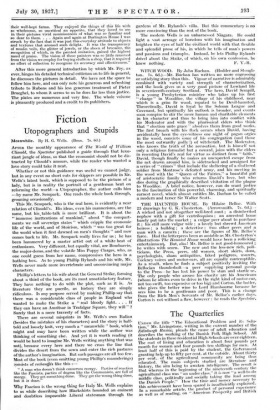A Taste for Texture
Flemish Art : A Critical Survey. By Roger Fry. (Chatto and Windus. 6s.)
MR. ROGER FRY has republished a lecture which he delivered at the Queen's Hall last March on the subject of the Exhibition of Flemish Art which was held last year at Burlington House. That exhibition was notable, not only for the substantial glories of Low Country art, but also for its extraordinary and unprecedented popular success. One was positively jostled by the crowd which thronged the galleries. As Mr. Fry puts it :
" The English are often accused by their too candid foreign friends of being grossly practical, incapable of responding to the things of the spirit, insensitive to the refining influence of the arts. Those who have frequented Burlington House in the past few months and watched the crowds of people of all classes waititg patiently in close-pressed queues in order to stare for a few seconds at a few square inches of painted panel must have felt the gross injustice of this accusation—may almost have wished, for their own convenience, that it had been a little less untrue."
He has an extremely interesting explanation of the fact that Flemish art has a far greater appeal to the average Englishman than has Italian. He says of their art that : " Both its qualities and defects arise from the fact that these
people found themselves very much at home on the surface of our planet. They were entirely satisfied with the profitable industry of their cosy, familiar townships, and with the rude plenty. of their well-kept farms. They enjoyed the things of this life with so wholesome, so uncritical an appetite, that they loved to see in their pictures vivid reminiscences of what was so familiar and so dear to them.. . . Again and again at Burlington House I was struck by the fact that it was just this everyday attitude to objects and textures that aroused such delight. It was the transparency of muslin veils, the glitter of jewels, or the sheen of brocades, the recognition of which, in the painted imitation, gained the highest mead of praise. The vision of these painters was so little removed from the vision we employ for buying stuffs in a shop, that it required no effort of reflection to recognize its accuracy and effectiveness."
After this more general introduction by which Mr. Fry, as ever, hinges his detailed technical criticism on to life in general, he discusses the pictures in detail. We have not the space to follow him here, and can only note his generous and refreshing tribute to Rubens and his less generous treatment of Pieter Brueghel, to whom it seems to us he does far less than justice. The plates are numerous and very fine. The whole volume is pleasantly produced and a credit to its publishers.



































 Previous page
Previous page